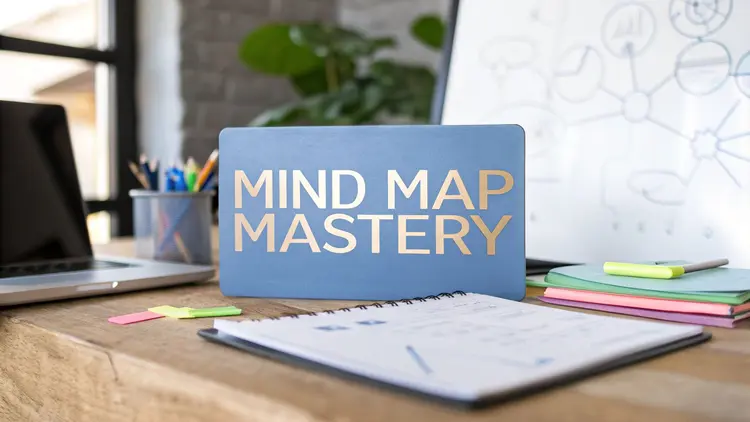Mind mapping isn’t just about creating colorful diagrams; it’s a technique rooted in the science of how our brains work. Instead of rigid, linear note-taking, mind maps embrace the brain’s natural, non-linear way of processing information through associations. This helps us connect ideas and learn more intuitively.
Traditional note-taking often forces information into a structured, list-like format. Mind mapping, on the other hand, allows you to build a web of interconnected thoughts. This makes learning more engaging and less like memorizing isolated facts.
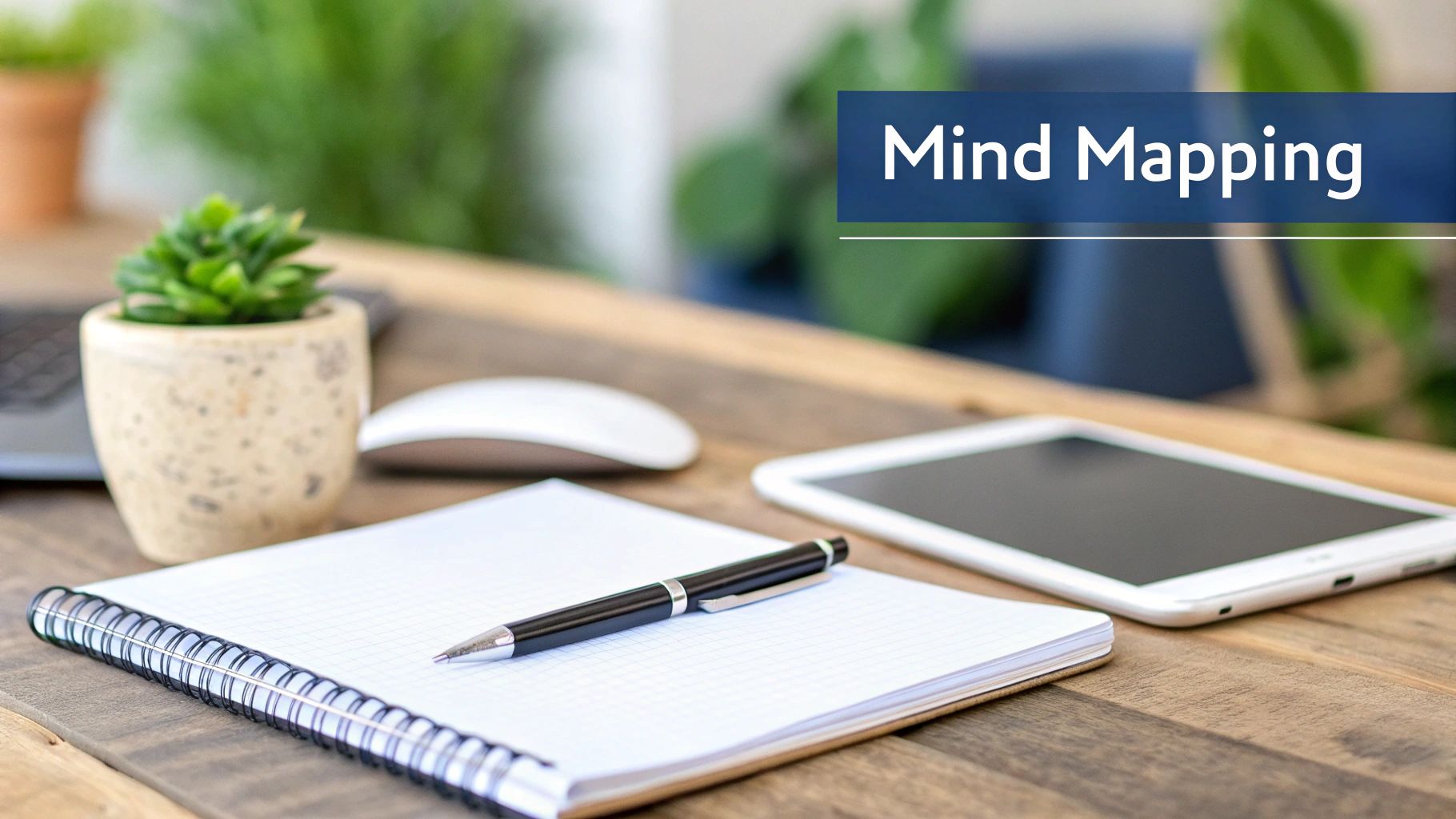
Tony Buzan pioneered this approach, recognizing the power of radial thinking. This involves branching ideas outwards from a central concept, using a central image as a mental anchor. Imagine mind mapping “healthy eating.” A picture of a vibrant salad at the center is more effective than just the words, triggering related thoughts and making exploration easier. Want to explore another powerful organizational technique?
Check out this guide on How to master bullet journaling.
Why Mind Maps Work So Well
Mind maps are effective because they align with our brain’s natural learning processes. Studies show they can boost learning and study efficiency by up to 15% compared to traditional methods. This improvement comes from the visual, structured layout that makes organizing and retaining information easier.
Research also suggests mind mapping can improve memory by an impressive 32%, making recalling information much simpler.
Mind maps emphasize the use of keywords and images, which reduces cognitive overload and lets your brain focus on the key ideas. Visuals further enhance memory and recall, creating multiple access points for the information in your long-term memory.
Combining words and images strengthens the connections between ideas. This makes retrieval easier later. This means mind mapping isn’t just about organizing thoughts; it’s a powerful tool for improving memory and overall learning effectiveness.
Building Blocks of Mind Maps That Actually Work
What makes a mind map truly effective? What separates a powerful tool for brainstorming and learning from a chaotic jumble of lines and words? This section explores the key components that transform a simple diagram into a dynamic and impactful mind map. Understanding these core elements will empower you to create mind maps that are both visually appealing and cognitively optimized.
The Power of the Central Image
The central image acts as the anchor of your mind map. It’s the focal point that sets the tone and theme for the entire map. While a central word can suffice, a vibrant and relevant image creates a stronger impression. Imagine you’re creating a mind map about “effective gardening techniques.” A picture of a flourishing garden teeming with colorful flowers and healthy vegetables will be more engaging than just the words “gardening techniques.” Visuals resonate with our brains, creating a more memorable and stimulating starting point for idea generation.
Radial Hierarchy: Mirroring Your Brain
The most effective mind maps employ a radial hierarchy. This structure mimics the way our brains naturally process information: by association. Main ideas branch directly from the central image, with secondary ideas branching from those main ideas, and so on. This visually represents the connections between concepts, creating a clear and structured overview of your topic. This interconnectedness is crucial for understanding complex subjects and generating new ideas.
Keywords: Less is More
When labeling the branches of your mind map, keep it concise. Single keywords are more impactful than long phrases or sentences. This streamlined approach reduces cognitive overload and keeps your focus sharp. For example, instead of writing “Ways to improve communication skills,” use keywords like “Listen,” “Empathize,” and “Clarify.” Combining keywords with relevant images can further boost recall by as much as 400%.
Strategic Use of Color and Images
Color and imagery aren’t just decorative elements; they’re essential tools for enhancing the effectiveness of your mind map. Assigning different colors to different branches creates visual distinctions between concepts, improving organization and clarity. Strategically placed images work synergistically with keywords, acting as visual cues that trigger memories and associations. These techniques leverage the way our brains process information, making mind maps more effective for both generating and retaining ideas.
To help you visualize these elements working together, let’s look at the following table summarizing how to create effective mind maps:
Core Elements of Effective Mind Maps
A breakdown of the essential components that should be included in every mind map and why each matters
| Element | Purpose | Implementation Tips |
|---|---|---|
| Central Image | Provides a visual anchor for the entire mind map. | Choose a compelling image related to the topic. |
| Branches | Represent main ideas and their connections. | Use keywords for labels, not sentences. |
| Sub-Branches | Expand on main ideas with supporting details. | Keep them concise and focused. |
| Keywords | Label branches and sub-branches clearly. | Use action verbs and strong nouns. |
| Color | Differentiate and organize branches. | Use a consistent color scheme. |
| Images | Enhance keywords and trigger visual associations. | Use relevant and memorable images. |
This table provides a concise guide for maximizing the impact of your mind maps. By incorporating these core elements, you can create powerful tools that enhance your thinking process and unlock new levels of understanding.
Creating Your First Mind Map: A Step-by-Step Guide
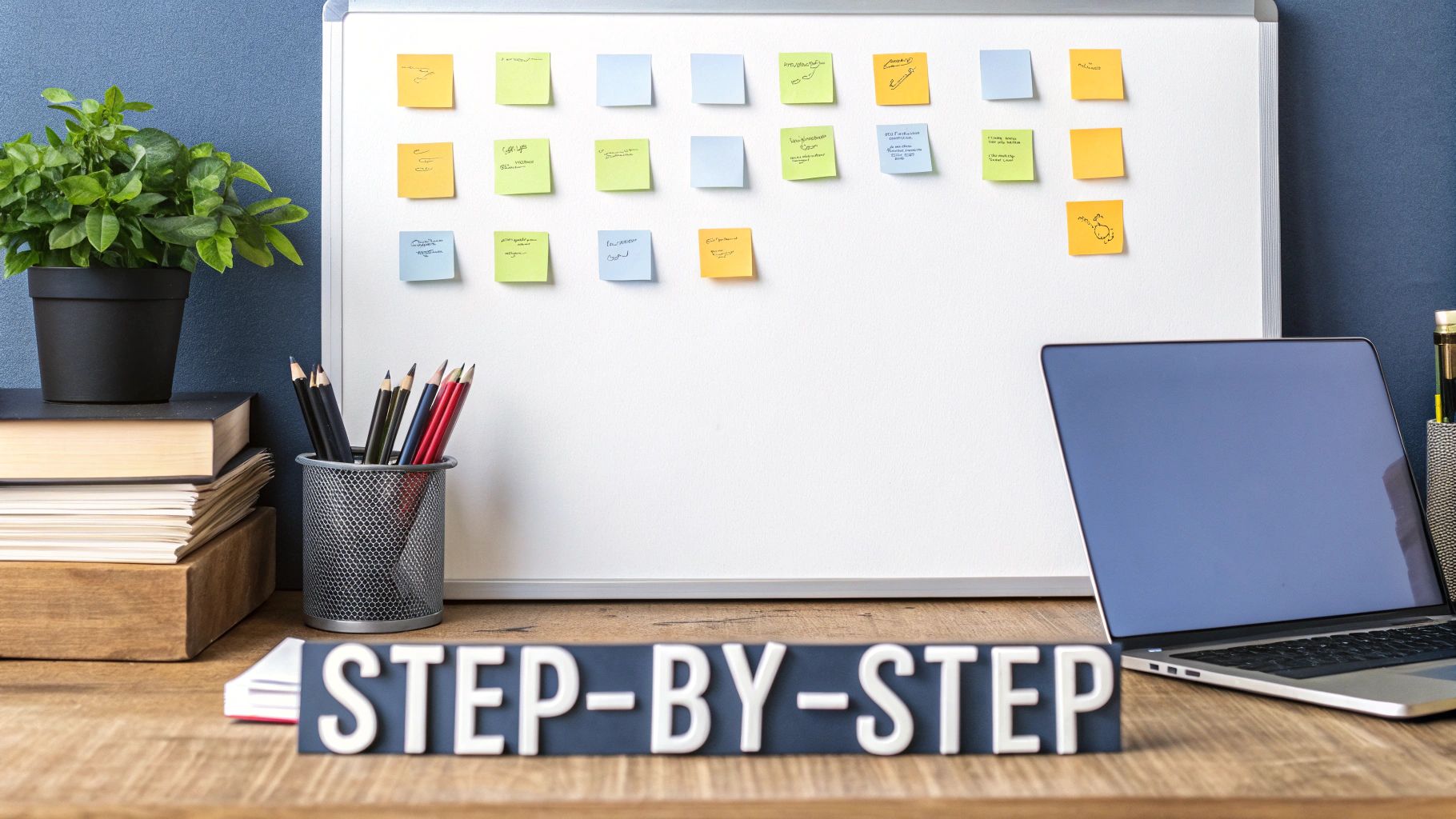
Turning a blank page into a dynamic mind map might seem a little intimidating at first. But with a straightforward process, you can easily unlock the potential of this visual thinking tool. This guide will walk you through creating effective mind maps, from gathering your materials to polishing your final design.
Getting Started: The Core of Your Mind Map
First, choose your central theme. This is the heart of your mind map, so pick a concise topic or question that represents the main idea you want to explore. This core concept could be a single word, a short phrase, or even a striking image to anchor your thoughts. Place this central theme in the middle of your page, making it the clear starting point for all your branches.
For example, if you’re brainstorming “content marketing strategies,” a lightbulb could be your central image, representing the generation of ideas. Your primary branches will flow outward from this central image.
Building Outward: Primary and Secondary Branches
Next, create your primary branches. These are the main ideas directly related to your central theme. These branches should extend from the center, visually connecting related concepts. Use keywords or short phrases for each branch label to keep things clear and concise.
So, for “content marketing strategies,” primary branches might be “SEO,” “Social Media,” and “Email Marketing.”
Now, add secondary branches. These sprout from your primary branches, adding details and refining your ideas. This structure organizes complex information into digestible chunks, breaking down broad concepts into more specific actions or arguments.
For instance, under the “SEO” branch, secondary branches like “Keyword Research” and “Link Building” provide further detail. This process effectively maps your thoughts. Mind mapping is a proven learning strategy, particularly for boosting knowledge and information recall.
A study of 112 medical students found that those using mind maps scored higher on both immediate and delayed retention tests than those using traditional methods, demonstrating the effectiveness of visual learning. Learn more about the effectiveness of mind mapping as a learning strategy.
Enhancing Your Mind Map With Visual Cues
Using visual elements makes your mind map clearer and easier to remember. Different branch colors can distinguish categories and create a more engaging visual. Images and symbols reinforce keywords, acting as memory aids and adding visual interest.
Read also: Can Bullet Journaling Save Your Day?
Refining and Revising: The Final Touches
As you build your mind map, feel free to revise and refine it. Rearrange branches, add connections, and tweak keywords until the structure and information flow feel right. This process encourages exploration and helps you discover connections between ideas. This flexibility makes mind mapping a valuable tool for brainstorming and learning.
Digital vs. Hand-Drawn: Choosing Your Perfect Approach
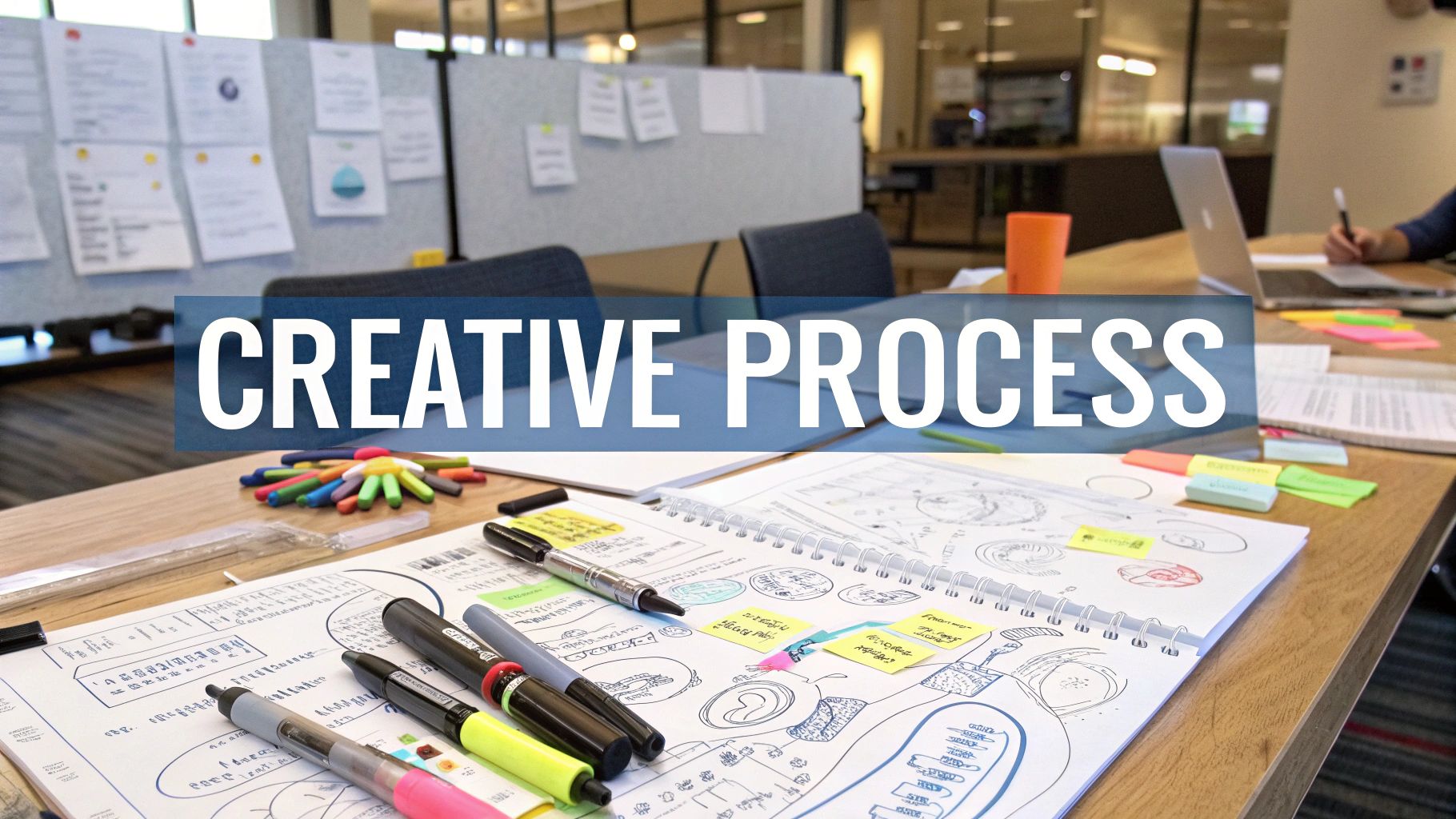
So, you’re ready to start mind mapping? Great! The first step is choosing your medium: digital or hand-drawn. This might seem like a small detail, but it can actually have a big impact on how you brainstorm, learn, and remember information. This section will explore the pros and cons of both approaches to help you find the best fit for your needs.
The Cognitive Benefits of Hand-Drawing
Hand-drawing a mind map engages kinesthetic learning. The physical act of writing and drawing activates different parts of your brain, which can boost memory and recall. Think of it like learning to play an instrument. The physical practice builds muscle memory and deepens your understanding of the music. In the same way, drawing connections between ideas helps solidify them in your mind. Studies even suggest this hands-on approach could improve retention by 29%.
Hand-drawing also encourages more deliberate thinking. Because you can’t instantly rearrange things like you can with digital tools, you’re encouraged to think carefully about each connection. This leads to deeper processing of information. This mindful approach helps you analyze relationships between concepts, leading to a richer understanding of the topic.
The Power and Flexibility of Digital Mind Maps
While hand-drawing has cognitive benefits, digital mind mapping shines in other ways. Digital tools like XMind or MindManager offer amazing flexibility. You can easily add, delete, and move elements, making revisions simple. This is especially helpful for complex projects or team collaborations. Imagine effortlessly shifting branches, changing colors, adding multimedia without smudging or redrawing entire sections. Digital platforms also enable smooth collaboration, allowing teams to work together on mind maps in real-time, no matter where they are.
Digital mind maps are also easy to share and search, making them ideal for project management, brainstorming, and knowledge sharing. You can export them in different formats, connect them with other software, and access them from anywhere. This makes them a powerful tool for individual and group projects.
Hybrid Approach: Combining the Best of Both Worlds
Maybe the most effective approach is combining both methods. Start with a hand-drawn mind map to get the cognitive benefits of kinesthetic learning. Then, transfer your ideas to a digital platform like FreeMind for easy editing, collaboration, and sharing. This hybrid approach combines the strengths of both, giving you the cognitive boost of hand-drawing and the flexibility of digital tools.
To help you further, let’s take a closer look at a direct comparison:
To help you decide, let’s compare the two methods side-by-side:
Digital vs. Traditional Mind Mapping Comparison A comprehensive comparison of digital and hand-drawn mind mapping approaches across various factors
| Factor | Digital Mind Mapping | Traditional Mind Mapping | Best For |
|---|---|---|---|
| Cost | Can require software purchase | Low cost (pen and paper) | Budget-conscious individuals |
| Flexibility | Easy to edit and rearrange | Limited editing options | Complex projects, revisions |
| Collaboration | Real-time collaboration features | Difficult to collaborate remotely | Team projects, shared brainstorming |
| Accessibility | Accessible from any device | Limited accessibility | Working on the go, remote access |
| Visual Appeal | Professional look, multimedia integration | Can be visually appealing but limited | Presentations, sharing with others |
| Cognitive Benefits | Less kinesthetic engagement | Enhances memory and recall through physical act of drawing | Individuals seeking improved retention |
The table above highlights some of the key differences between digital and traditional mind mapping, giving you a clearer picture of what each offers. Digital excels in flexibility and collaboration, while traditional shines in cognitive benefits and simplicity.
Ultimately, the best approach depends on your preferences, the specific task, and your workflow. Try both methods to discover what works best for you!
Customizing Mind Maps For Different Thinking Tasks
Thinking is a diverse process, and mind mapping should reflect that. This section explores how to tailor your mind maps to specific thinking tasks, turning them from general brainstorming tools into powerful, specialized learning, planning, and problem-solving instruments. This adaptability is the key to unlocking mind mapping’s full potential. For example, a mind map for studying a complex topic will look very different from one designed to spark creative ideas.
Mind Maps For Complex Study Scenarios
Organizing information is paramount when dealing with multi-disciplinary subjects or preparing for comprehensive exams. Start with a central image representing the overarching theme. Create primary branches for each major topic, using distinct colors to differentiate them. Extend secondary and tertiary branches from these primary branches for subtopics, key concepts, and supporting details. This hierarchical structure helps you visualize the connections between subjects, improving comprehension and retention.
Adding visual elements like diagrams, charts, and even mnemonics alongside keywords can further enhance understanding. For example, include a small image of a DNA double helix within a branch related to genetics in a biology mind map. This helps connect abstract concepts with visual representations.
Project Management Adaptations
Mind maps can also be dynamic project management tools. Use a central image representing the project’s overall goal. Primary branches can represent key project phases or deliverables. Secondary branches then break down each phase into individual tasks, subtasks, and dependencies.
You might be interested in: How to Use Bullet Journaling for ADHD.
Incorporate timelines, deadlines, and assigned team members directly within the mind map for a comprehensive visual project overview. This helps identify potential bottlenecks, track progress, and keep everyone aligned.
Enhancing Creative Thinking
Mind maps can be invaluable for overcoming mental blocks and generating innovative ideas. Unlike the structured study approach, creative mind maps thrive on a more free-flowing structure. Start with a central image that represents the problem or challenge. Then, branch out in all directions with associated ideas, keywords, and photos, without being overly concerned with strict hierarchies. The goal is to encourage free association and uncover unexpected connections.
This non-linear approach can lead to breakthrough ideas that might not surface through traditional brainstorming. Using colors, images, and symbols can further ignite creativity and help visualize different aspects of a problem. Mind mapping is a versatile tool adaptable to different learning styles and preferences.
Focused Note-Taking Strategies
Mind maps provide a highly effective method for taking notes in information-rich environments, like lectures or conferences. Use a central image representing the main topic, then create branches for key themes, speakers, or discussion points. Record key takeaways, supporting data, and relevant insights on secondary branches. This structured yet flexible approach allows you to capture essential information while maintaining a clear overview of the overall topic.
Avoiding the Mind Map Mistakes That Sabotage Results
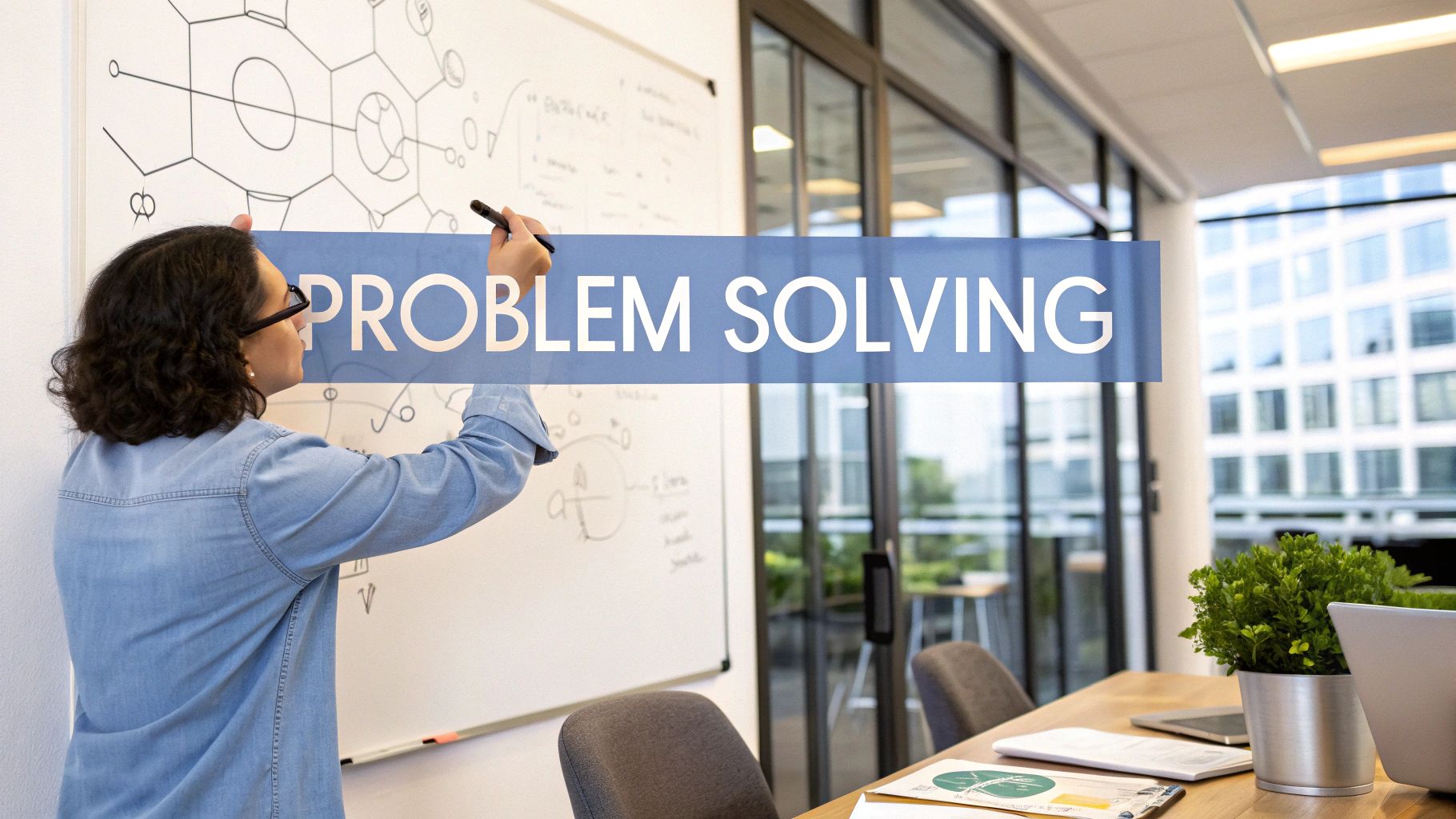
Creating a mind map is about more than just connecting ideas. It’s about connecting them effectively. Even experienced mind mappers can stumble into common traps that cloud clarity and limit a mind map’s true potential. This section explores these pitfalls and offers solutions to help you transform your mind maps into powerful tools for thinking, learning, and problem-solving.
Overcrowding: Suffocating Clarity
One of the most common mistakes is overcrowding. Stuffing too much information into a small space makes the map visually overwhelming and hard to follow, defeating the whole purpose of creating a visual aid for clarity.
For example, using long sentences instead of keywords clutters the branches, making it difficult to grasp the core ideas. The solution? Maintain optimal information density.
Focus on using concise keywords and short phrases. This approach boosts clarity and helps your brain process the information more effectively.
For more tips on achieving mental clarity, check out this helpful article on Mental Clarity Exercises.
Inconsistent Visuals: Confusing Your Brain
Another frequent error is inconsistency in the visual elements. A random mix of colors, fonts, and image styles creates visual chaos. This inconsistency can confuse your brain and make it harder to spot connections between ideas.
The fix is easy: create a clear visual hierarchy. Use consistent colors for related branches, select a legible font, and stick to a uniform style for images and icons. This creates visual coherence, making your mind map much easier to understand and navigate.
Poor Hierarchy: Creating Navigation Problems
A poorly defined hierarchy makes it challenging to understand the relationships between different concepts. If the connections between main ideas and subtopics are unclear, the mind map loses organizational power.
The solution is to build clear relationships. Start with a central idea and create primary branches for the main topics. Then, develop secondary and tertiary branches for subtopics and supporting details. This structured approach creates a map that’s easy to follow and understand.
Perfectionism: Reducing Effectiveness
It might seem counterintuitive, but aiming for a “perfect” mind map can actually hinder its effectiveness. Spending too much time on aesthetics or getting everything “just so” can stifle the creative process.
Remember, mind maps are meant to be flexible and evolve. Embrace imperfection! Focus on capturing your ideas first, then refining and organizing them later. This allows for a more fluid and dynamic thought process, maximizing your mind map’s potential.
Memory-Boosting Mind Map Techniques That Stick
Mind maps are fantastic for organizing information. But did you know they can also be powerful tools for improving memory? We’re talking about turning your mind maps from simple diagrams into active tools for long-term retention. Let’s explore some research-backed techniques that take mind mapping from organization to memorization.
Spaced Repetition and the Art of Reviewing
Want to remember something for the long haul?
Spaced repetition is key.
This involves reviewing material at increasingly longer intervals. It’s like giving your brain a nudge just as it’s about to forget something. For example, review your mind map the day after you create it. Then, revisit it three days later, then a week later, and so on. This helps reinforce those neural pathways and solidify the information in your long-term memory.
Progressive Simplification: Strengthening Neural Pathways
Progressive simplification is another helpful technique. After creating a detailed mind map, make a simplified version focusing only on the main points. Then, create an even more condensed version. This process helps you distill the information down to its core, much like creating an outline before writing an essay. This strengthens your understanding and makes it easier to recall the information later.
Multisensory Encoding: Engaging Multiple Brain Regions
Get all your senses involved!
When creating or reviewing your mind map, say the keywords out loud. Use different colored pens. You could even associate physical actions with different concepts, like tapping your foot while reviewing a particular branch. This multisensory encoding creates multiple pathways to the information in your brain, making it easier to remember.
Self-Testing With Mind Maps: Active Recall for Retention
Turn your mind map into a self-testing tool! Cover up parts of your mind map and try to remember the hidden information. This active recall is way more effective than passive review. It transforms your mind map into a dynamic learning tool, making the learning process more engaging and effective. Plus, it’s been shown that mind mapping can improve long-term retention of factual material by as much as 10%, which is a big deal for students preparing for exams.
For more on studying and personal growth, check out this interesting article: Why Your Partner Should Be An Integral Part Of Your Personal Growth. You can also explore additional resources on memory retention here.
Integrating Mind Maps With Other Memory Systems
Combine the power of mind mapping with other proven memory techniques. Think about using mnemonics or the method of loci. You could create a mind map that visually represents the steps in a mnemonic device. Or, use locations on your mind map as “memory palaces” in the loci method. This combined approach leverages the strengths of each system for a synergistic boost to your memory.
Visual Elements for Enhanced Recall
Don’t forget about visuals! Use images, symbols, and colors that resonate with you. The more personalized your mind map, the more memorable and meaningful the information will be. Our brains are wired to remember things better when they’re connected to our emotions and personal experiences.
Conclusion
Using these techniques, you can transform your mind maps into dynamic tools for learning, remembering, and applying information. Want to learn more about maximizing your potential? Visit Lorelei Web for more insights on mind mapping, journaling, and other powerful tools for entrepreneurs.

Lorelei has been an online entrepreneur, marketer and writer since 2006. Her biggest passion is WordPress, which is why she switched to being a full-time blogger 20 years ago and hasn’t looked back since. With so many years of experience behind her, she is an expert in copywriting, SEO, marketing and business strategies.






